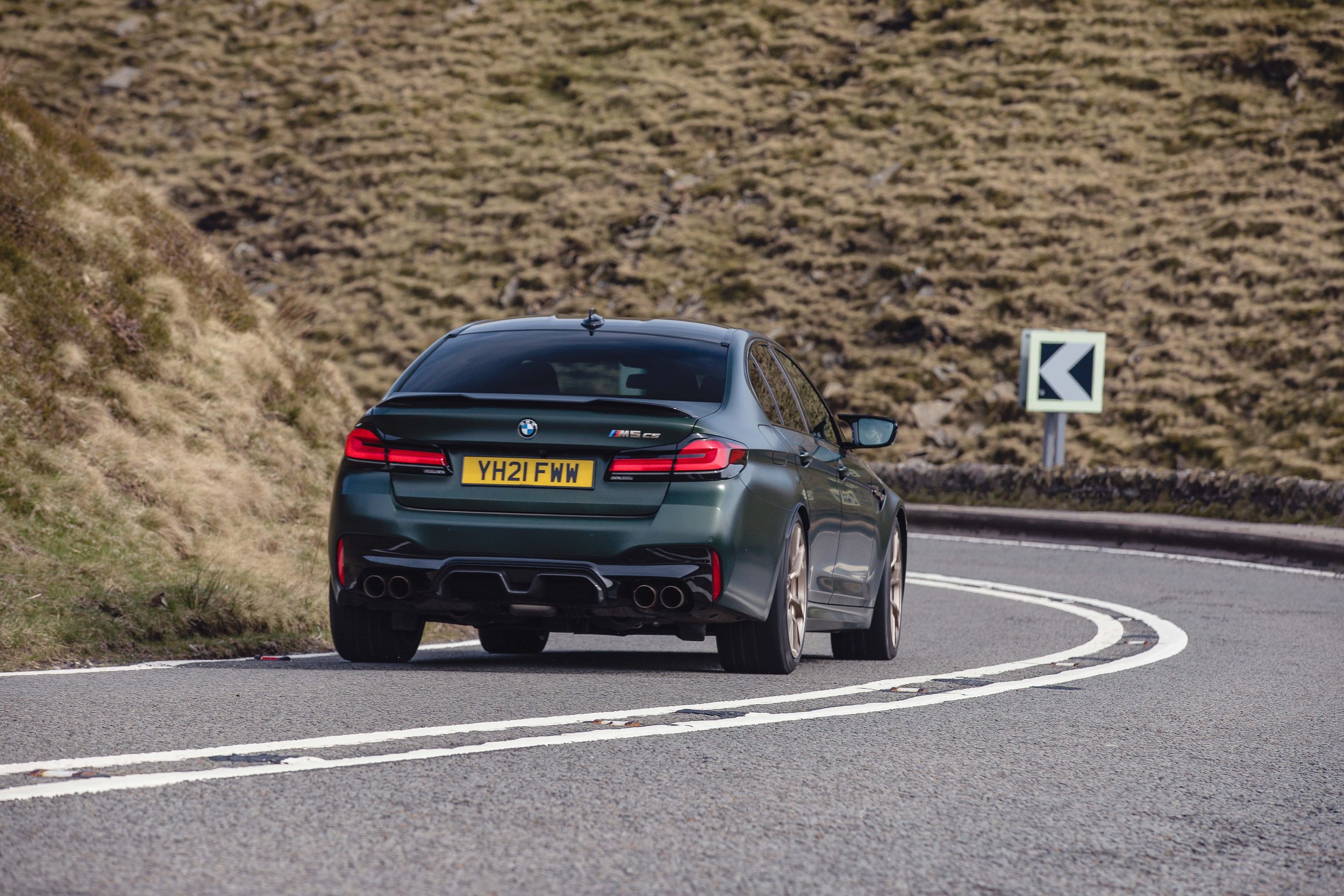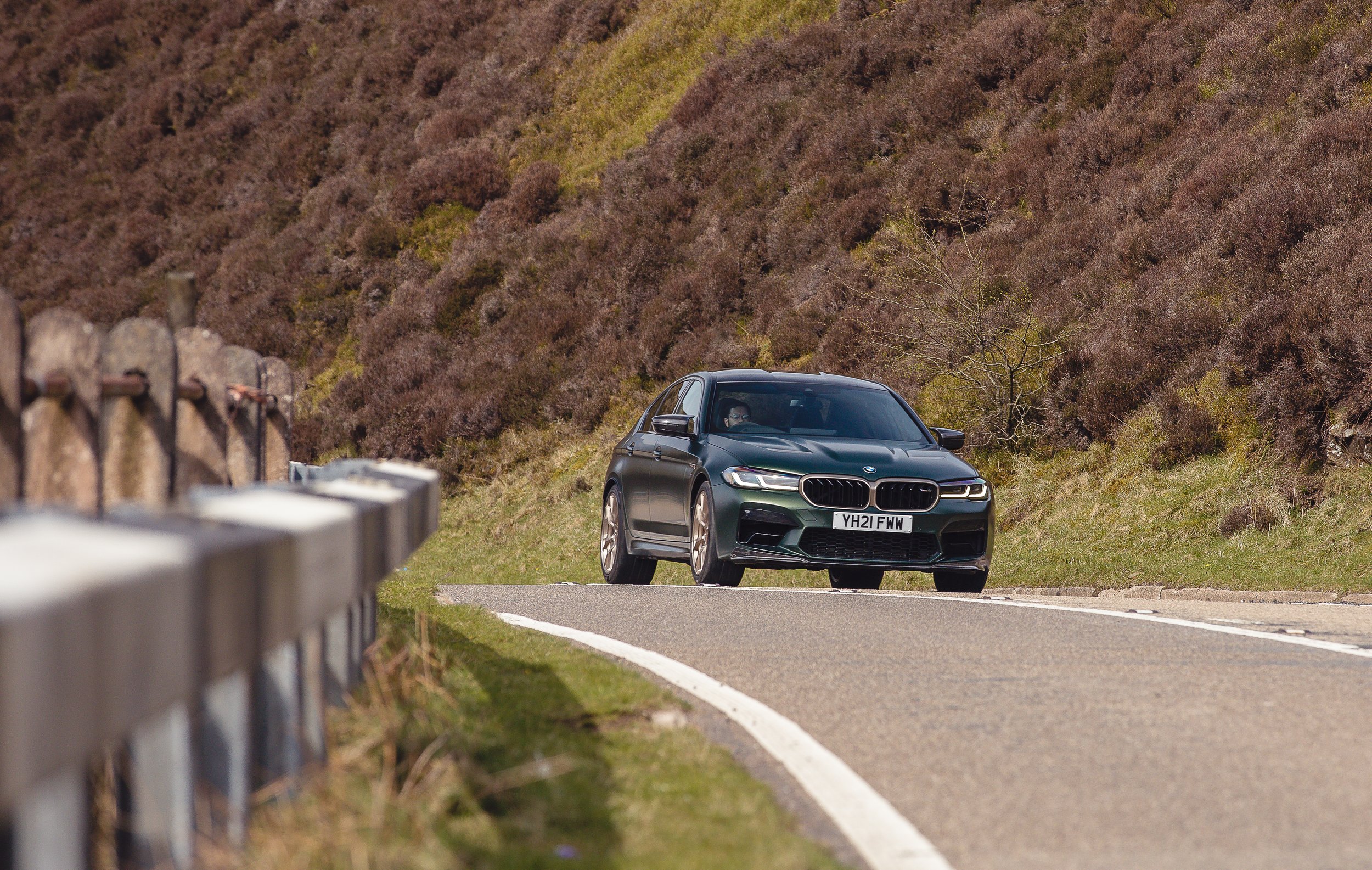
Road Test: BMW M5 CS
The BMW M5 CS is considered one of the greatest M Cars ever made, but is it worthy of the hype?
WORDS: Mark Rose | PHOTOS: Dom Ginn
In the world of BMW, the M5 has long been considered ‘the’ M car. Sure, Munich’s first foray in to M-badged road cars began in 1978 with the introduction of the M1, but it was the release of the M535i in 1979 which laid the groundwork for what many perceive as the first proper volume M car, the E28 M5. When the E28 burst on to the scene in 1984, it retained the comfort and practicality of a standard 5 Series, but with performance more akin to that of racers from BMW’s motorsport programme. It was the original fast saloon car and it kicked off a trend which continues to this very day. If we’re talking pedigree, then BMW M is to modern performance saloons, what the Lamborghini Miura is to today’s crop of mid-engine supercars. It’s the daddy.
Since the 80s however, cars have become larger and heavier, and the M5 is no exception. The E28 weighed 1430kg, making it something of a featherweight compared to today’s selection of performance saloons. For context, the latest and greatest F90 M5 CS is some 400kg heavier than its ancestor, and amusingly the CS is supposed to be the ‘lightweight’ version of the standard M5 Competition.
Weighing some 70 kilos less than an M5 Comp, BMW has achieved this by fitting it with carbon ceramic brakes which alone save 23kg and reduce unsprung mass. They’ve thrown out the Competition’s standard seats and replaced them with buckets all-round including carbon seats up front, and there’s also a carbon bonnet, forged alloy wheels and less sound deadening. Munich could have easily stripped more weight out of the M5, but this isn’t some track focussed GTS variant, but a road car that’s designed to offer increased dynamic ability while not forgoing the luxuries that make an M5 a stunning daily driver. Besides, there’s more than one way to skin a cat, or in this case, an M car, so BMW has also dropped the ride height by 7mm and given the M5 the adaptive dampers from the M8 Gran Coupe. Oh, and it has an extra 10bhp.


Less weight, tighter body control and a bump in power have transformed the way the M5 drives, particularly over a country road. In the Competition model, it’s difficult to ignore the mass you’re carrying around, but the revisions made for the CS help mask its kerbweight and sharpen the driving experience in every way – it feels like a 1600-ish kilo car, not one that weighs 1825kg at the kerb. The front end is more responsive, the body resists roll in a physics defying way, and it has unbreakable composure over a bumpy road. Even some of the best performance vehicles can become unsettled on a rough B-road, particularly when you’re trailing in on the brakes, but the M5 CS has no such issues, it just rides the bumps, settles and turns in to the corner. It is deeply confidence inspiring in a way that a 626bhp super saloon shouldn’t be, especially when you consider that xDrive is predominantly rear-biased. The M5 CS may send its power to all four wheels – something purists love to scoff at – but it feels like a rear driven machine. A dab of throttle on corner entry helps get the car rotated in to the turn and instead of power oversteer on the corner exit, you feel the benefit of xDrive as the tyres bite in to the tarmac and fire your down the road. You benefit from the adjustability but not the waywardness associated with potent rear-wheel drive cars, which makes the CS a very fast car across the ground.
It may be oddly approachable, but there’s nothing vague about the way the M5 goes about its business. The steering communicates what the front wheels are doing through a purposeful, Alcantara-clad rim, the brake pedal is well judged and allows for progressive braking, and the gearbox is the snappiest ZF auto I’ve come across. A twin-clutch gearbox would have been welcome when you’re really pushing on, but then BMW runs the risk of detracting from the CS’ ability to cruise like an M5 should by using a less refined ‘box.
You don’t realise how broadly talented the CS is until you take it away from the country roads and on to some motorways. During our time with it, we took a visit to the Peak District which meant we spent a lot of time using the M1, and during that trip, the word that kept springing to mind was ‘Bahnstormer’. I’ve driven faster cars, but nothing that’s ever felt so insulted by the prospect of a dull 70mph along the two inside lanes of a motorway. Not that we broke the speed limit at any time … but you quickly realise that the M5 is made to sit in the outside lane at 100mph for hours on end. It’s quiet, comfortable and capable of ferrying four grown adults and their luggage cross-country without missing a beat. But when you peel off the boring, camera-infested motorway and on to some country lanes, the M5 CS shakes off its Financial Times persona and turns in to a real supercar slayer at the click of a button. BMW allow you to change the engine and gearbox mapping, suspension set up and steering weight individually of each other and then save your preferences to the appropriately named M1 and M2 buttons on the steering wheel. We had M1 set up for cruising at the, err, aforementioned 70mph, and M2 for the type of driving I can’t speak freely about on the internet.


You’ll notice that we haven’t touched on performance yet. That too is outstanding, but with only 10bhp more than an M5 Competition, it represents the smallest difference between the CS and its lesser sibling. What you pay for here is the improved dynamic ability and sense of connection, but 626bhp is still a lot and therefore we should address it. The CS is in fact the most powerful road-going M car ever made, at least from factory anyway. The twin-turbocharged 4.4 litre V8 makes peak power at 6,000rpm and 553lb ft. between 1,800rpm and 5,950rpm. It’s devastatingly fast with a zero to 62mph time of just 3.0 seconds (three tenths quicker than an M5 Comp) and a limited top speed of 189mph. Make no mistake, without the limiter this is a 200mph M5. It’s that fast. Unlike heavily turbocharged engines, it also has exceptional throttle response and it doesn’t run out of momentum as you approach the limiter. You just revel in the response and keep your eyes pinned open as you power towards the horizon.
The interior is very much a mixture of ‘sensible’ M5 Competition and lightweight CS. All the creature comforts that super saloon drivers expect are present and correct, but the smattering of CS and Nürburgring logos, carbon-backed bucket seats, Alcantara steering wheel, and individual buckets for the rear seats make it feel more special than an M5 Comp while helping shed excess weight.
The front seats might look like medieval torture devices, and they can be a bit of a faff to get in and out of, but they hold you in all the right places and over a long distance, they’re surprisingly comfortable. The same can be said for the rear buckets that you drop in to and offer fantastic support. You also get the benefit of added leg room thanks to the front seats being slimmer than the standard items in the M5 Competition.


To the annoyance of some, the cabin is one spec with no colour or trim options, but the materials that are on display are of high quality and the interior is well built. The infotainment is BMW’s iDrive system which, unlike other modern systems, can still be operated with physical buttons and a click wheel – attempting to prod at a screen while spanking your M5 CS across a country road is a recipe for disaster. The CS is not a car that you want to write off because only 26 of them have come to the UK, so the chances of seeing another are vanishingly small. They’re also all sold, at the supposedly controversial list price of £140,000, with lightly used examples now changing hands for well above that figure. And well all gawped when BMW originally announced pricing …
As is often the case, though, driving is believing and you simply have to drive the BMW M5 CS to truly appreciate its breadth of ability. On paper, the revisions would you lead to believe that it’s a slightly lighter version of an M5 Competition with some fancy dampers, shiny logos and an inflated price, but it’s much more than that. The changes are transformative. It outperforms every other F90 M5 to date, and sets the bar for what performance saloon cars are capable of. The term ‘supercar slayer’ is one that gets thrown around too regularly, but it’s a title that the M5 CS is deserving of.
Dynamic prowess aside, you could argue that scarcity is what makes it so deeply desirable. The CS makes car enthusiasts very hot under the collar, and well, let’s not get started on the BMW fanboys and M car owners who lose their minds at the sight of it. It’s achingly special and like its E28 M5 ancestor, the F90 M5 CS will surely go down in history as one of the all-time great M cars.
Engine: V8, twin-turbo
Displacement: 4,395cc
Power: 626bhp @ 6,000rpm
Torque: 553lb ft @ 5,950rpm
Transmission: 8-speed auto, AWD
0-62mph: 3.0 secs
VMAX: 189mph
Kerbweight: 1,825kg
Price: £140,700 (when new)
Technical Specifications
If you were lucky enough to get one, then well played. The BMW M5 CS is one of the very best M Cars in recent times and a benchmark vehicle in the super saloon segment.
10/10
Verdict & Rating
“The M5 CS shakes off its Financial Times persona and turns in to a real supercar slayer at the click of a button”


